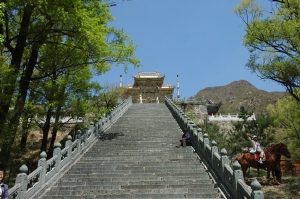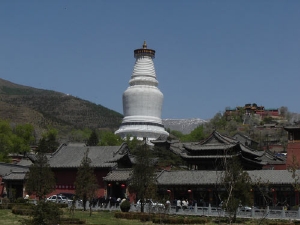Wu Tai Shan
A holy place of buddhism unity
Sacred buddhist mountain in China
 The center of Chinese Buddhism for two thousand years, Wu Tai Shan was originally a Taoist sacred mountain known as Tzu-fu Shan, meaning ‘Purple Palace Mount,’ and was believed to be the abode of various Taoist immortals. Wu Tai Shan actually encompasses a number of different mountains, but long ago Buddhists chose five particular flat-topped peaks as the perimeter of the sacred area, hence the name which means ‘Five Terrace Mountain’. The highest peak, at 10,033 feet, is called Northern Terrace and the lowest, at 8153 feet, is called Southern Terrace; between these two peaks stretch twelve miles of mountains.
The center of Chinese Buddhism for two thousand years, Wu Tai Shan was originally a Taoist sacred mountain known as Tzu-fu Shan, meaning ‘Purple Palace Mount,’ and was believed to be the abode of various Taoist immortals. Wu Tai Shan actually encompasses a number of different mountains, but long ago Buddhists chose five particular flat-topped peaks as the perimeter of the sacred area, hence the name which means ‘Five Terrace Mountain’. The highest peak, at 10,033 feet, is called Northern Terrace and the lowest, at 8153 feet, is called Southern Terrace; between these two peaks stretch twelve miles of mountains.
The first temples on Wu Tai Shan were built during the reign of Emperor Ming Di, 58-75 AD and textual sources describe an estimated 200 temples erected during the Northern Ch’i dynasy of 550-577 AD, but subsequently destroyed. Today, fifty-eight temples built after the Tang Dynasty (A.D. 684-705) still stand as well as the oldest wooden temple in all of China, the Nan Chan Si temple built in 782 AD. There are forty-eight temples of Chinese Buddhism and ten Tibetan Lamasaries. Taihuai town, in the center of the Wu Tai mountains, is surrounded by the five peaks. Most of the temples are located near the town. The peaks of Wu Tai and all the surrounding temples are sacred to Manjushri, the Buddhist Bodhisattva of Wisdom and Virtue. Scholars trace the beginning of the Manjushri association with Wu Tai Shan to the visit of an Indian monk who visited in the 1st century AD and reported a vision of the Bodhisattva. Manjushri (called Wenshu Pusa in Chinese) is believed to reside in the vicinity of Wu Tai Shan and numerous legends speak of apparitions of the Bodhisattva riding a blue lion in the high mountains above the monasteries.
Wu Tai Shan is widely known not only to the people of China but also to Buddhists in Japan, India, Sri Lanks, Burma, Tibet and Nepal. Wu Tai’s Buddhism is indissolubly tied up with that of Japan and had a great influence on that country. Seeking after the Buddhist truth, such famous monks as Ennin and Ryoosen in the Tang Dynasty, and Choonen and Seisan in the Song Dynasty made long pilgrimages to Wu Tai Shan. The Tantric master Amoghavajra also came to meditate here.


– Source : sacredsite.com
– Related articles :




